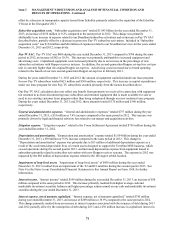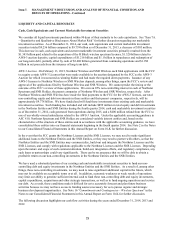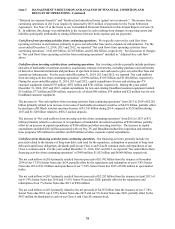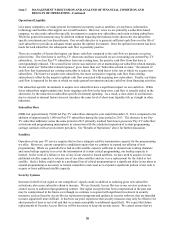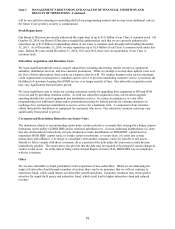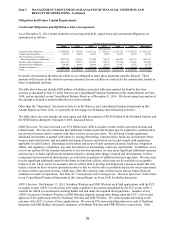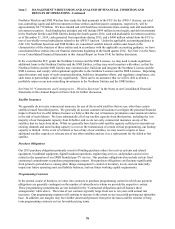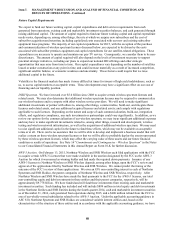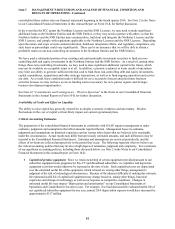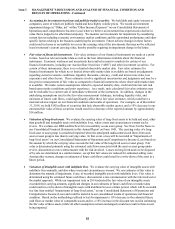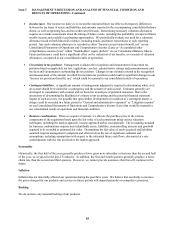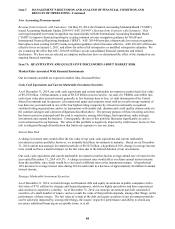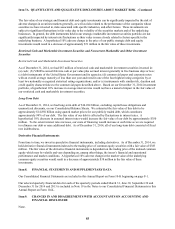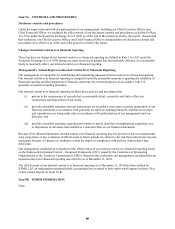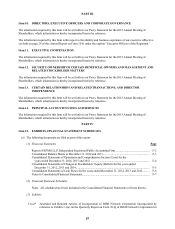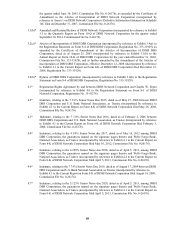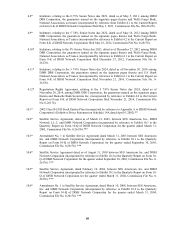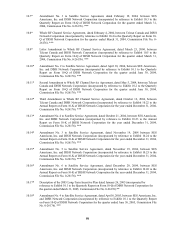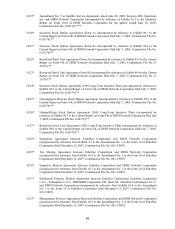Dish Network 2014 Annual Report Download - page 91
Download and view the complete annual report
Please find page 91 of the 2014 Dish Network annual report below. You can navigate through the pages in the report by either clicking on the pages listed below, or by using the keyword search tool below to find specific information within the annual report.Item 7. MANAGEMENT’S DISCUSSION AND ANALYSIS OF FINANCIAL CONDITION AND
RESULTS OF OPERATIONS - Continued
81
81
consolidated these entities into our financial statements beginning in the fourth quarter 2014. See Note 2 in the Notes
to our Consolidated Financial Statements in this Annual Report on Form 10-K for further discussion.
In the event that the FCC grants the Northstar Licenses and the SNR Licenses, we may need to make significant
additional loans to the Northstar Entities and the SNR Entities, or they may need to partner with others, so that the
Northstar Entities and the SNR Entities may commercialize, build-out and integrate the Northstar Licenses and the
SNR Licenses, and comply with regulations applicable to the Northstar Licenses and the SNR Licenses. Depending
upon the nature and scope of such commercialization, build-out, integration efforts, and regulatory compliance, any
such loans or partnerships could vary significantly. There can be no assurance that we will be able to obtain a
profitable return on our non-controlling investments in the Northstar Entities and the SNR Entities.
We have used a substantial portion of our existing cash and marketable investment securities to fund our non-
controlling debt and equity investments in the Northstar Entities and the SNR Entities. As a result of, among other
things, these non-controlling investments, we may need to raise significant additional capital in the future, which
may not be available on acceptable terms or at all. In addition, economic weakness or weak results of operations
may limit our ability to generate sufficient internal cash to fund these non-controlling debt and equity investments,
capital expenditures, acquisitions and other strategic transactions, as well as to fund ongoing operations and service
our debt. As a result, these conditions make it difficult for us to accurately forecast and plan future business
activities because we may not have access to funding sources necessary for us to pursue organic and strategic
business development opportunities.
See Note 16 “Commitments and Contingencies – Wireless Spectrum” in the Notes to our Consolidated Financial
Statements in this Annual Report on Form 10-K for further discussion.
Availability of Credit and Effect on Liquidity
The ability to raise capital has generally existed for us despite economic weakness and uncertainty. Modest
fluctuations in the cost of capital will not likely impact our current operational plans.
Critical Accounting Estimates
The preparation of the consolidated financial statements in conformity with GAAP requires management to make
estimates, judgments and assumptions that affect amounts reported therein. Management bases its estimates,
judgments and assumptions on historical experience and on various other factors that are believed to be reasonable
under the circumstances. Actual results may differ from previously estimated amounts, and such differences may be
material to the Consolidated Financial Statements. Estimates and assumptions are reviewed periodically, and the
effects of revisions are reflected prospectively in the period they occur. The following represent what we believe are
the critical accounting policies that may involve a high degree of estimation, judgment and complexity. For a summary
of our significant accounting policies, including those discussed below, see Note 2 in the Notes to our Consolidated
Financial Statements in this Annual Report on Form 10-K.
Capitalized premise equipment. Since we retain ownership of certain equipment provided pursuant to our
subscriber equipment lease programs for Pay-TV and Broadband subscribers, we capitalize and depreciate
equipment costs that would otherwise be expensed at the time of sale. Such capitalized costs are depreciated
over the estimated useful life of the equipment, which is based on, among other things, management’s
judgment of the risk of technological obsolescence. Because of the inherent difficulty of making this estimate,
the estimated useful life of capitalized equipment may change based on, among other things, historical
experience and changes in technology as well as our response to competitive conditions. Changes in
estimated useful life may impact “Depreciation and amortization” on our Consolidated Statements of
Operations and Comprehensive Income (Loss). For example, if we had decreased the estimated useful life of
our capitalized subscriber equipment by one year, annual 2014 depreciation expense would have increased by
approximately $117 million.


